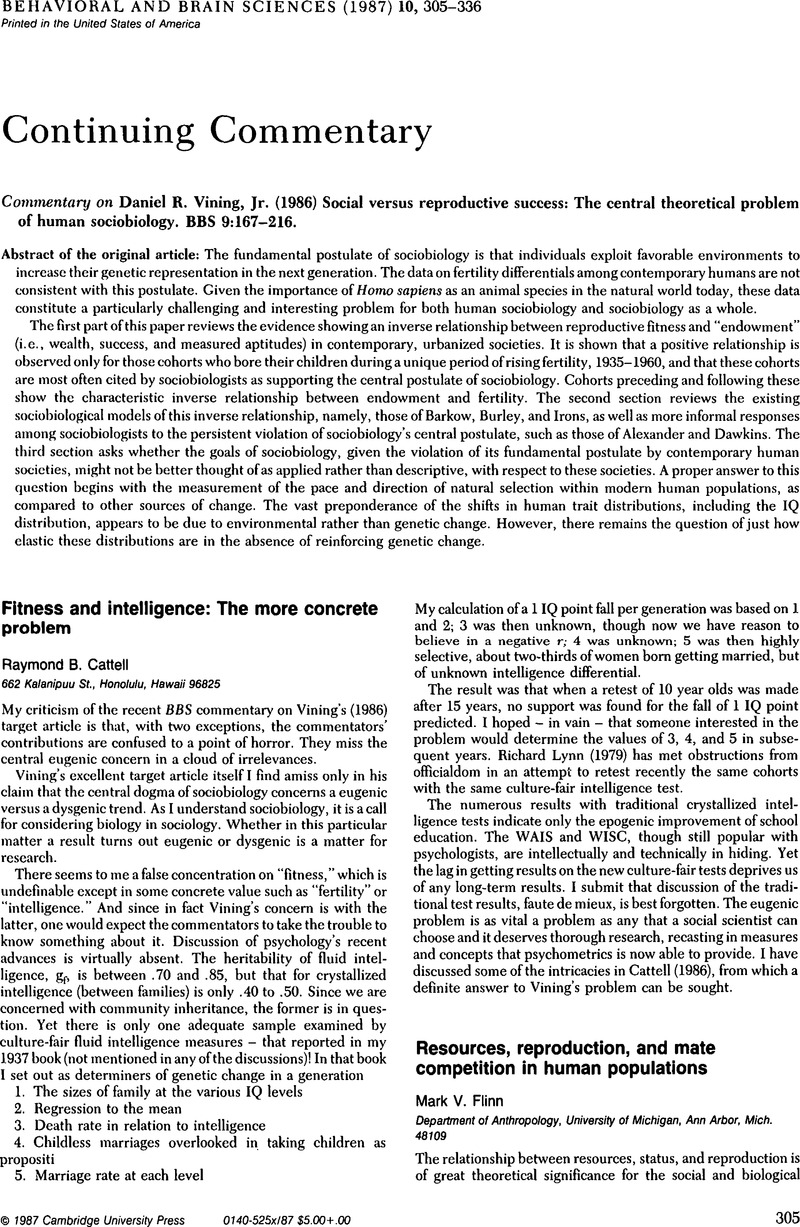Crossref Citations
This article has been cited by the following publications. This list is generated based on data provided by Crossref.
Roberts, Joseph Palmer
1990.
The sociobiology of ethnocentrism in an Indian City.
Ethology and Sociobiology,
Vol. 11,
Issue. 6,
p.
465.
Turke, Paul W.
1990.
Which humans behave adaptively, and why does it matter?.
Ethology and Sociobiology,
Vol. 11,
Issue. 4-5,
p.
305.
Kenrick, Douglas T.
1993.
Do these sociobiologists have an answer for everything?.
Behavioral and Brain Sciences,
Vol. 16,
Issue. 2,
p.
299.
Pérusse, Daniel
1993.
Cultural and reproductive success in industrial societies: Testing the relationship at the proximate and ultimate levels.
Behavioral and Brain Sciences,
Vol. 16,
Issue. 2,
p.
267.
Bookstein, Fred L.
1993.
Converting cultural success into mating failure by aging.
Behavioral and Brain Sciences,
Vol. 16,
Issue. 2,
p.
285.
Hill, Elizabeth M.
1993.
Are our reproductive choices affected by aspects of socioeconomic resources?.
Behavioral and Brain Sciences,
Vol. 16,
Issue. 2,
p.
294.
Dupré, John
1993.
Scientism, sexism and sociobiology: One more link in the chain.
Behavioral and Brain Sciences,
Vol. 16,
Issue. 2,
p.
292.
Alcock, John
1993.
Exadaptations.
Behavioral and Brain Sciences,
Vol. 16,
Issue. 2,
p.
283.
Wilson, Margo
1993.
What is the adaptation: Status striving, status itself or parental teaching biases?.
Behavioral and Brain Sciences,
Vol. 16,
Issue. 2,
p.
311.
Plotkin, H. C.
1993.
Stretching the theory beyond its limits.
Behavioral and Brain Sciences,
Vol. 16,
Issue. 2,
p.
303.
Hartung, John
1993.
Pérusse is right.
Behavioral and Brain Sciences,
Vol. 16,
Issue. 2,
p.
294.
Mealey, Linda
1993.
Sociobiology or evolutionary psychology? The debate continues.
Behavioral and Brain Sciences,
Vol. 16,
Issue. 2,
p.
300.
Mueller, Ulrich
1993.
Actual and potential reproduction: There is no substitute for victory.
Behavioral and Brain Sciences,
Vol. 16,
Issue. 2,
p.
301.
Carey, Gregory
1993.
The status/reproduction correlation: But what is the mechanism?.
Behavioral and Brain Sciences,
Vol. 16,
Issue. 2,
p.
289.
Kaplan, Hillard
1993.
The problem of resource accrual and reproduction in modern human populations remains an unsolved evolutionary puzzle.
Behavioral and Brain Sciences,
Vol. 16,
Issue. 2,
p.
297.
Irons, William
1993.
Monogamy, contraception and the cultural and reproductive success hypothesis.
Behavioral and Brain Sciences,
Vol. 16,
Issue. 2,
p.
295.
Pérusse, Daniel
1993.
Human status seeking is a Darwinian adaptation.
Behavioral and Brain Sciences,
Vol. 16,
Issue. 2,
p.
312.
Kemper, Theodore D.
1993.
Social dominance attainment, testosterone, libido and reproductive success.
Behavioral and Brain Sciences,
Vol. 16,
Issue. 2,
p.
298.
Thompson, Nicholas S.
1993.
Oh no! Not social Darwinismagain!.
Behavioral and Brain Sciences,
Vol. 16,
Issue. 2,
p.
309.
Wahlsten, Douglas
1993.
Sociobiology flops again.
Behavioral and Brain Sciences,
Vol. 16,
Issue. 2,
p.
310.





